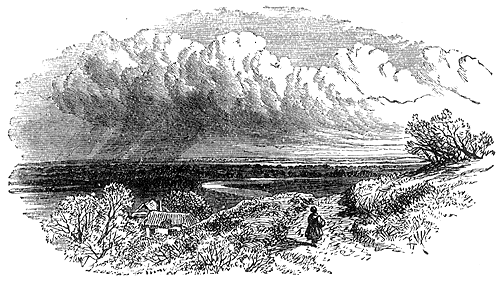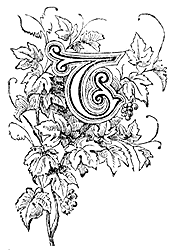In the time of the kingdom of Mercia it was a royal village, and the favourite residence of their kings. Offa, the greatest of these sovereigns, resided at Tamworth, and dates a charter to the Monks of Worcester from it. By an invasion of the Danes Tamworth was entirely destroyed, but the wonderful Ethelfleda, the daughter of Alfred, rebuilt the town in 913, after she had by her valour freed the king's dominions from the pirates. She built a tower also on part of the artificial mound on which the castle was afterwards erected, and here she dwelt till her death. She was one of the noblest women to whom England has given birth, and the greatest benefactor the Saxons knew. Wherever a town was destroyed Ethelfleda built it up; was a place defenceless and exposed, she fortified it. She died in 920, and two years later Tamworth and all the Mercian towns and tribes submitted the power of Ethelfleda's brother, Edward. The town, even as late as the reign of Henry VIII., was built of timber. The poet Michael Drayton was born in this neighbourhood, on the banks of the Anker; he probably took his name from Drayton, a place on the western border of the county. Drayton Basset and Drayton Manor are two of the finest seats in Staffordshire. Near Drayton is Bloreheath, where the Lancastrians and Yorkists fought one of the battles of the Roses; the former were commanded by Lord Audley and the latter by the Earl of Salisbury. Queen Margaret watched the battle from a neighbouring steeple, and saw the Lancastrians fly. The town and castle of Tamworth were bestowed by the Conqueror on Robert de Marmion, 1 one of his most devoted followers. Marmion had also the manor of Scrivelsby, in Lincolnshire, granted to him Both these estates were held on champion service, that is, their possessor had to attend at the coronation of every king on horseback, and to defy any one who should object to the rightful title of the sovereign, throwing down his glove as a challenge. This service had hitherto been paid by the ancestors of Marmion to the Dukes of Normandy, and was continued till the reign of William IV. "This Robert being settled at Tamworth," says Sir Walter Scott, "expelled the nuns he found here to Oldbury, about four miles distant. A year after this he gave a costly entertainment at Tamworth Castle to a party of friends, among whom was Sir Walter de Somerville, Lord of Whichover, his sworn brother. Now it happened that as he lay in his bed St. Edith appeared to him in the habit of a veiled nun, with a crozier in her hand, and advertised him that if he did not restore the Abbey of Polesworth (which lay within the territories of his Castle of Tamworth) unto her successors, he should have an evil death and go to hell; and that he might be more sensible of this her admonition, she smote him on the side with the point of her crozier, and so vanished away. Moreover, by this stroke being much wounded, he cried out so loudly that his friends in the house arose; and finding him extremely tormented with the pain of his wound, advised him to confess himself to a priest, and vow to restore the nuns to their former possessions. Furthermore, having done so, his pain ceased, and in accomplishment of his vow (accompanied by Sir Walter de Somerville and others) he forthwith rode to Oldbury, and craving pardon of the nuns for the injury done, brought them back to Polesworth, desiring that himself and his friend, Sir Walter de Somerville, might be regarded as their patrons, and hence have burial for themselves and their heirs in this abbey, viz., the Marmions in the chapter house, and the Somervilles in the cloister. However some circumstances of this story may seem fabulous, the substance of it is perfectly true, for it appears by the very words of his charter that he gave to Osanna, the prioress." We are bound to believe that he was wounded, and restored the priory, but we think the strong hand that could so severely wound, could not have belonged to gentle St. Edith. A singular fate befell his son and heir, Robert. He and the Earls of Chester were deadly enemies. The Lords of Chester had a noble seat at Coventry, not very far from Marmion's castle. Robert Marmion entered the priory there, which was, we suppose, under the earl's protection, or on his land; he (Marmion) drove out the monks, fortified the priory, and dug deep ditches in the adjacent fields, which he covered lightly with branches and earth, so that any horseman approaching might be entrapped. But it so happened that be was caught in his own snare, for as he rode out to examine the Earl of Chester's forces, which were approaching to attack him, he forgot the exact situation of the ditches, and fell into one. He broke his thigh by the fall, and v as unable to release himself; and thus he remained till a soldier saw him, seized him, and cut off his head. Four generations of Marmions possessed Tamworth after this unlucky Robert, and then the family became extinct in the person of Philip de Marmion, who died in Edward I.'s reign. The Tamworth family had meantime lost the championship. Baldwin de Freville, fourth Lord of Tamworth, had claimed it; but it was adjudged to belong to the Manor of Scrivelsby, and as that had descended to the Dymocks through a co-heiress of Robert de Marmion, it was decreed that Sir John Dymock was hereditary Champion of England, and the honour remains in his family to the present day, Mr. Dymock being always addressed as "Champion." The family and possessions of Freville became merged in the Earls of Ferrers; and has subsequently become the possession of the Marquis Townsend, in right of the heiress of the Comptons. The present Castle of Tamworth stands on an elevation, and has an air of grandeur about it; its architecture is of different periods. The exterior is in tolerable repair, and the hall is perfect, but rude and comfortless in appearance. Leland says, speaking in the time of Henry VIII., "The base court and great ward of the castle is cleane decayed, and the wall fallen downe, and therein be now but houses of office of noe notable building. The dungeon hill yet standeth, and a great round tower of stone, wherein Mr. Ferrers dwelleth, and now repaireth it." There are fine bay windows in the drawing and dining rooms, and the views from these over the river at the foot of the castle mount are very fine. Around the dining room are emblazoned the arms of the family. The name of Tamworth is immortalised by being mentioned in Shakspeare. On a plain near the town Richmond halted his forces on his march to Bosworth Field, and the poet makes him thus address his followers:- The great and excellent statesman, Sir Robert Peel, was member for Tamworth for many years, and his constituents, proud of his fame and grateful for all he did for them, have erected his statue by subscription in their town. It stands in the Market Place with its back to London and its face towards the place of his birth; on the right is the church he attended, and on the left Drayton Manor, the noble dwelling he built.  * * * * * *
1. Scott used the name for one of his finest poems, but assures us that the character was wholly imaginery. 2. Richard III.'s cognizance was a boar. |
||||
